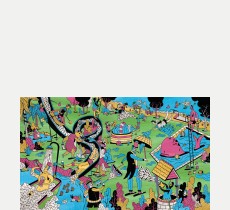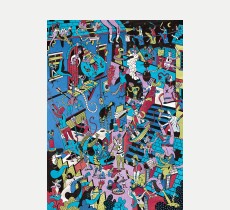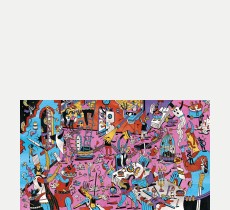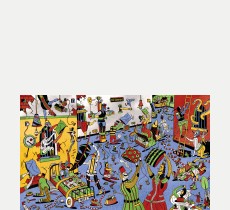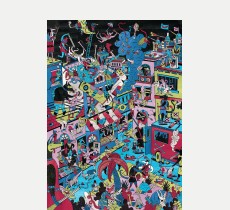Known for his elaborate fight scenes, Phil Wrigglesworth's clients include The Guardian, Computer Arts magazine, Wired, New Scientist and Penguin Books. We caught up with Phil and talked about his creative process, thoughts on the future of illustration and his preferred professions of cricketer and Cold War spy.
Can you describe how you make images?
Firstly I start by reading the brief and exploring the possibilities of the topic in the sketchbook, drawing anything I feel might be related to the subject matter. This process continues until I feel all the angles have been opened up are document, both written and drawn.
An idea or possible direction is only safe once drawn in the sketchbook, so this is an important part of my methodology, so ideas don’t just float off into the nights sky. Then its coffee time and the brain gets to work on its own filtering and reflecting almost without any conscious input from myself. Twenty minutes later when I return the initial sketches and bite size elements start gluing together and developing almost on their own. When I feel the ideas are taking shape its coffee time again and the process of natural development letting the brain ferment over what I have just drawn takes place.
Twenty minutes later when I return the ideas are narrowed down to a couple I feel fit the brief or topic the best and the final developments to get the correct message are developed. Then I draw the idea again and again and again to get to know the space and the shapes of the pictorial elements, as my final drawing will fall from hand, through the pencil onto the paper almost as a continual line drawing and when this happens I know its been developed fully. If I need to stop and make alterations then I know I don’t understand the space of the image and its needs developing further. The the idea and drawing is complete and then onto the artwork and that’s a secret process I’m afraid.
Do you keep you style consistent or is it something that is always developing?
My way of working is an ever shifting consistent process which is always developing through a collection of minor tweaks to the process along the mythological line of production. A slight adjustment to the sketching process and a slight change to the colour palette and a slight change to the rendering over time makes a large shift in style that isn’t noticeable directly, unless artworks are sat side by side.
Where do you think illustration is heading at the moment?
Illustration as an industry has changed dramatically over the past few years, mainly through technological advances. The marketplace has no geographical restrictions due to the power of sending images over the internet. Printing work has become much more cost effective and this has enabled illustrators to become their own Gallerists over the internet. The traditional printed platforms of promotion for illustrators have almost become a thing of the past and illustrators have much more control of their own practice and how their practice is perceived through personal websites. The speed of producing work using the computer as the main tool has enabled illustrators become much more multi professional, taking on roles as such Art Directors or Typographers.
So where is the industry heading? I believe the major change to happen next is in traditional editorial medias, the continuation of free content can’t continue and changes have to happen for newspapers and magazines to survive.
How will this effect illustration? Once customers are paying for on line content then budgets will appear and the possibilities of animated illustration, narrative illustration and interactive illustration is an very exciting possibility and is already starting to happen with printed matter being sold through the iPad.

Apart from your illustration what do you do?
Being an illustrator is my third choice as a profession, my first would have been to be a cricket player for my county of Lancashire and as this is just a dream now, play for England against Australia. But I have to be content with watching at the Oval (the nearest ground to where I live) and listening to cricket on the radio and while I work and always have the dulcet tones of the Test Match Special commenter's on in the back ground.
My second choice of profession is a Cold War spy working in Berlin, unfortunately the opportunities are now limited in the field due to the collapse of communism, but there is still some great films to watch and books to consume myself in. Reading not just spy fiction but all genres of fiction is something I love to do, especially in the back garden in the summer.
Take a look at Phil's artwork for sale or visit his website.

